Tendon and ligament imaging
- PMID: 22553301
- PMCID: PMC3495576
- DOI: 10.1259/bjr/34786470
Tendon and ligament imaging
Abstract
MRI and ultrasound are now widely used for the assessment of tendon and ligament abnormalities. Healthy tendons and ligaments contain high levels of collagen with a structured orientation, which gives rise to their characteristic normal imaging appearances as well as causing particular imaging artefacts. Changes to ligaments and tendons as a result of disease and injury can be demonstrated using both ultrasound and MRI. These have been validated against surgical and histological findings. Novel imaging techniques are being developed that may improve the ability of MRI and ultrasound to assess tendon and ligament disease.
Figures




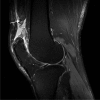




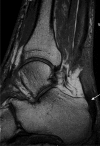





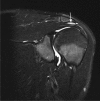


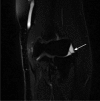


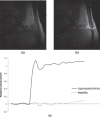
Similar articles
-
Magnetic resonance imaging of ankle tendons and ligaments: part I - anatomy.Australas Radiol. 2007 Aug;51(4):315-23. doi: 10.1111/j.1440-1673.2007.01752.x. Australas Radiol. 2007. PMID: 17635466 Review.
-
Magnetic resonance imaging of tendon and ligament abnormalities: Part I. Spine and upper extremities.Skeletal Radiol. 1992;21(1):1-9. doi: 10.1007/BF00243084. Skeletal Radiol. 1992. PMID: 1546330
-
The athlete's hand: ligament and tendon injury.Semin Musculoskelet Radiol. 2012 Sep;16(4):338-49. doi: 10.1055/s-0032-1327007. Epub 2012 Oct 9. Semin Musculoskelet Radiol. 2012. PMID: 23047281 Review.
-
Evaluation of the quadriceps tendon, patellar tendon, and collateral ligaments after total knee arthroplasty: appearances in the early postoperative period.Can Assoc Radiol J. 2006 Dec;57(5):291-8. Can Assoc Radiol J. 2006. PMID: 17265984
-
Normal anatomy and pathologic conditions of ankle tendons: current imaging techniques.Radiographics. 1992 May;12(3):429-44. doi: 10.1148/radiographics.12.3.1609136. Radiographics. 1992. PMID: 1609136
Cited by
-
Irreducible ankle fracture dislocation due to posterior tibialis tendon interposition: Diagnostic and clues for early management - A case report.Trauma Case Rep. 2019 Mar 2;20:100175. doi: 10.1016/j.tcr.2019.100175. eCollection 2019 Apr. Trauma Case Rep. 2019. PMID: 30906840 Free PMC article.
-
The Accuracy of Distal Clavicle Fracture Classifications-Do We Need an Amendment to Imaging Modalities or Fracture Typing?J Clin Med. 2022 Sep 24;11(19):5638. doi: 10.3390/jcm11195638. J Clin Med. 2022. PMID: 36233506 Free PMC article.
-
Utility of MRI for Evaluation of a Common Calcaneal Tendon Rupture in a Dog: Case Report.Front Vet Sci. 2020 Sep 4;7:602. doi: 10.3389/fvets.2020.00602. eCollection 2020. Front Vet Sci. 2020. PMID: 33088830 Free PMC article.
-
Principles and applications of the balanced steady-state free precession sequence in small animal low-field MRI.Vet Res Commun. 2018 Mar;42(1):65-86. doi: 10.1007/s11259-017-9708-7. Epub 2018 Jan 4. Vet Res Commun. 2018. PMID: 29302913 Review.
-
Tissue-Specific T2 * Biomarkers in Patellar Tendinopathy by Subregional Quantification Using 3D Ultrashort Echo Time MRI.J Magn Reson Imaging. 2020 Aug;52(2):420-430. doi: 10.1002/jmri.27108. Epub 2020 Feb 28. J Magn Reson Imaging. 2020. PMID: 32108398 Free PMC article.
References
-
- Pierre-Jerome C, Moncayo V, Terk MR. MRI of the Achilles tendon: a comprehensive review of the anatomy, biomechanics, and imaging of overuse tendinopathies. Acta Radiol 2010;51:438–54 - PubMed
-
- Rich A, Crick FH. The structure of collagen. Nature 1955;176:915–16 - PubMed
-
- Rich A, Crick FH. The molecular structure of collagen. J Mol Biol 1961;3:483–506 - PubMed
-
- Ramachandran GN, Chandrasekharan R. Interchain hydrogen bonds via bound water molecules in the collagen triple helix. Biopolymers 1968;6:1649–58 - PubMed
-
- Fullerton GD, Rahal A. Collagen structure: the molecular source of the tendon magic angle effect. J Magn Reson Imaging 2007;25:345–61 - PubMed
Publication types
MeSH terms
Grants and funding
LinkOut - more resources
Full Text Sources
Other Literature Sources
Medical

